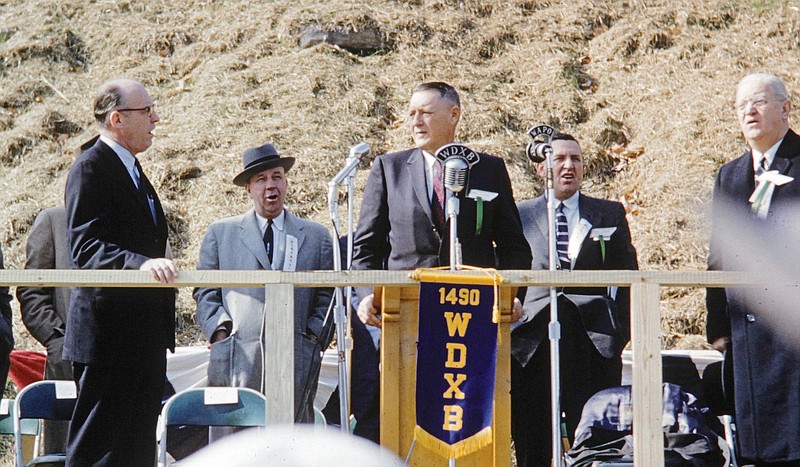Infrastructure spending is in the news.
But back in mid-20th century Chattanooga, the undisputed king of infrastructure was P.R. "Rudy" Olgiati, a three-term mayor of the city who served from 1951 to 1963, a period of post-war expansion of Chattanooga's highways, bridges and tunnels.
Mayor Olgiati, shown here in a Nov. 17, 1959, photo, is pictured at the dedication ceremony of the Olgiati Bridge, which was tagged with his name while he was still in office.
The photo is part of a collection of vintage images at ChattanoogaHistory.com curated by Sam Hall. Hall says this color photo is a family heirloom shared by Tony St. Charles, son of the late Signal Mountain attorney and businessman Pat St. Charles Jr.
Simultaneously that day in November 1959, a major urban renewal project that resulted in the topping of Cameron Hill and displacement of hundreds of residents was given the name Golden Gateway. A banner headline in the Chattanooga News-Free Press read: "West Side is 'Golden Gateway,' Olgiati Bridge open to the public."
Golden Gateway was the product of a naming contest sponsored by the Chattanooga Jaycees club that drew 865 entries. The second-place entry was Cameron Center and the third-leading vote-getter was Metro Center, according to news reports.
At the time, Hamilton County Judge Wilkes T. Thrasher, who also had a namesake bridge over the Chickamauga Dam, observed of the Olgiati Bridge opening, "I'm not one to think a man ought to die before you pass him the flowers."
ChattanoogaHistory.com
Launched by history enthusiast Sam Hall in 2014, ChattanoogaHistory.com is maintained to present historical images in the highest resolution available.If you have photo negatives, glass plate negatives, or original non-digital prints taken in the Chattanooga area, contact Sam Hall for information on how they may qualify to be digitized and preserved at no charge.
On dedication day, other state and local dignitaries, along with four generations of his family, joined Olgiati on the stage, which was positioned on the north approach to the four-lane bridge. Later, the mayor was chauffeured across the bridge, with his car snapping a ribbon in the middle of the span.
That day, Olgiati remarked, "I guess that an honor like this only comes to a man once in a lifetime. Thank you from the bottom of my heart."
According to news reports, the Olgiati bridge was sorely needed. It was designed to cut traffic on the nearby John Ross (Market Street) Bridge by about a third from its peak of 35,000 vehicles per day. The Walnut Street Bridge, today a pedestrian walkway, was also open to vehicle traffic at that time.
News reports set the cost of the Olgiati Bridge at $6.2 million, which was just a fraction of the tens of millions spent on infrastructure during Olgiati's three terms. Much of the money came from federal grants. (By contrast the recent upgrades to Highway 27 including the Olgiati Bridge are said to cost $143 million.)
According to a campaign ad in the Chattanooga Times in 1951, Olgiati was the son of Swiss immigrants. His maternal grandparents moved to Grundy County, Tennessee, in the 19th century. His father was said to be a highly educated man who spoke nine languages and came to America as an interpreter.
For his part, Olgiati was in the Army Corps of Engineers in World War II and served as a Chattanooga city commissioner before being elected mayor. He attempted to run for governor in the 1960s but failed to gain the nomination of the Democratic Party. He died in 1989 at age 87.
Follow the "Remember When, Chattanooga?" public group on Facebook.
Contact Mark Kennedy at mkennedy@timesfreepress.com.
